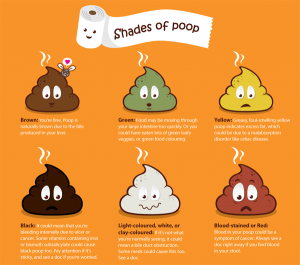
Source: scarymommy.com
Stools are the solid or semisolid remnants of the food that could not be absorbed in the small bowel. It contains bacteria and small amounts of excretes left over from the metabolic process. These are products that are no longer needed by our body, which our system should therefore expel.
Stool Composition
A stool is made up of about 30 percent solid substance made of dead bacteria, 30 percent indigestible food materials, 10 to 20 percent cholesterol and other fats, 10 to 20 percent inorganic substance like calcium and iron phosphate, and 2 to 3 percent protein.
Check Your Stool

Source: i.imgur.com
What food you ingest tells so much about your stool, and your stool color reveals so much about the condition of your gastrointestinal tract.
Avoid feeling awkward by learning how to examine your stool and know what each stool color means. Having this basic knowledge can help ease your nervousness and tell you if it is about time to see a doctor.
Stool Color And What It Means
The color of stool differs, but it is mostly of a brown hue, depending on the color of the food you ate.
Red, maroon, tarry, or black stool with a smell to it is somewhat concerning. Black tarry stool may mean bleeding in the upper GI tract such as the stomach. Bright red blood could be due to bleeding in the lower GI tract. Seeing small amounts of blood in the tissue paper may be due to hemorrhoids or a superficial wound to the rectal area. It should not alarm you, but if there are persistent streaks of bright red blood in the stool or tissue paper or you have bloody diarrhea, you should inform your doctor.
Yellow, greasy, and foul-smelling stool can mean excess fat in the feces which can sometimes be due to malabsorption disorder, concerning for possible celiac disease. It would be better to see a doctor for evaluation.
Pale-colored stool, white or clay-colored, accompanied by a change in urine color to dark color could mean you got a problem in your biliary tree, like a bile duct stone. Stone can obstruct your bile duct limiting the bile flow and causing the stool to be lighter in color. Watch out for any fevers, right-sided upper abdominal pain, chills, or turning yellow of the skin. When any of this happens, see your doctor immediately.
Green stool means your food could be moving through the large intestine in a fast phase due to diarrhea. It becomes green because the bile was not able to break the food down completely.
Blue stool rarely occurs but it can. It is caused by ingesting food with too much blue dye or coloring, and this food passes rapidly through the digestive tract. When you’re sure you just ate blue colored food, this should not be of concern. Consuming ferric ferrocyanide or Prussian blue – used in the treatment of heavy metal poisonings such as radiation, cesium, and thallium– can also cause your stool to turn blue.
Silver, tarnished-silver, or aluminum paint-like stool can be a result of biliary obstruction of any kind. Carcinoma of the ampulla of Vater can cause gastrointestinal bleeding and biliary obstruction, which turn your stool color to silver.
Purple or violet stool is a symptom of porphyria which is a cluster of disorders that is due to the buildup of natural chemicals that produce porphyrin in your body.
Don’t take the change in the color of your stool for granted. If something unusual concerns you, forget about the embarrassment and see your doctor immediately to ease your mind of worries.